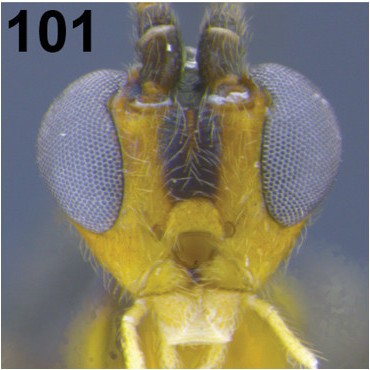|
Amicrocentrinae
The Amicrocentrinae are a subfamily of braconid Parasitic wasp, parasitoid wasps. Members of this subfamily were previously included in the Macrocentrinae. Description and distribution Amicrocentrinae are relatively large yellow or brown non-cyclostome braconids. This subfamily is found in Madagascar and continental Africa. Biology Some species within Amicrocentrinae are known to be parasitoids of large caterpillars which bore into plant stalks. References External links DNA barcodes at BOLD systems Braconidae Hymenoptera subfamilies {{Ichneumonoidea-stub ... [...More Info...] [...Related Items...] OR: [Wikipedia] [Google] [Baidu] |
Braconidae
The Braconidae are a family of parasitoid wasps. After the closely related Ichneumonidae, braconids make up the second-largest family in the order Hymenoptera, with about 17,000 recognized species and many thousands more undescribed. One analysis estimated a total between 30,000 and 50,000, and another provided a narrower estimate between 42,000 and 43,000 species. Classification The Braconidae are currently divided into about 47 subfamilies and over 1000 genera, which include ''Aerophilus'', ''Aleiodes'', ''Apanteles'', ''Asobara'', ''Bracon (wasp), Bracon'', ''Cenocoelius'', ''Chaenusa'', ''Chorebus'', ''Cotesia'', ''Dacnusa'', ''Diachasma'', ''Dimeris'', ''Microgaster'', ''Opius'', ''Parapanteles'', ''Phaenocarpa'', ''Spathius'', and ''Syntretus.'' These fall into two major groups, informally called the cyclostomes and noncyclostomes. In cyclostome braconids, the Labrum (arthropod mouthpart), labrum and the lower part of the Clypeus (arthropod anatomy), clypeus are concave ... [...More Info...] [...Related Items...] OR: [Wikipedia] [Google] [Baidu] |
Subfamily
In biological classification, a subfamily (Latin: ', plural ') is an auxiliary (intermediate) taxonomic rank, next below family but more inclusive than genus. Standard nomenclature rules end botanical subfamily names with "-oideae", and zoological subfamily names with "-inae". Detarioideae is an example of a botanical subfamily. Detarioideae is a subdivision of the family Fabaceae (legumes), containing 84 genera. Stevardiinae is an example of a zoological subfamily. Stevardiinae is a large subdivision of the family Characidae, a diverse clade In biology, a clade (), also known as a Monophyly, monophyletic group or natural group, is a group of organisms that is composed of a common ancestor and all of its descendants. Clades are the fundamental unit of cladistics, a modern approach t ... of freshwater fish. See also * International Code of Nomenclature for algae, fungi, and plants * International Code of Zoological Nomenclature * Rank (botany) * Rank (zoolo ... [...More Info...] [...Related Items...] OR: [Wikipedia] [Google] [Baidu] |
Parasitic Wasp
Parasitoid wasps are a large group of hymenopteran superfamilies, with all but the wood wasps ( Orussoidea) being in the wasp-waisted Apocrita. As parasitoids, they lay their eggs on or in the bodies of other arthropods, sooner or later causing the death of these host (biology), hosts. Different species specialise in hosts from different insect orders, most often Lepidoptera, though some select Coleoptera, beetles, Diptera, flies, or Hemiptera, bugs; the spider wasps (Pompilidae) exclusively attack spiders. Parasitoid wasp species differ in which host life-stage they attack: eggs, larvae, pupae, or adults. They mainly follow one of two major strategies within parasitism: either they are endoparasitic, developing inside the host, and koinobiont, allowing the host to continue to feed, develop, and moult; or they are ectoparasitic, developing outside the host, and idiobiont, paralysing the host immediately. Some endoparasitic wasps of the superfamily Ichneumonoidea have a mutuali ... [...More Info...] [...Related Items...] OR: [Wikipedia] [Google] [Baidu] |
Macrocentrinae
The Macrocentrinae are a subfamily of braconid parasitic wasps. Several species have been used in biological control programs. Description and distribution Macrocentrines are relatively large braconids, recognizable by the presence of small teeth on the trochantellus. Many have pale coloration and nocturnal habits. They belong to the noncyclostome group. They are found worldwide. Biology Macrocentrines include solitary and gregarious koinobiont endoparasitoids of caterpillar Caterpillars ( ) are the larval stage of members of the order Lepidoptera (the insect order comprising butterflies and moths). As with most common names, the application of the word is arbitrary, since the larvae of sawflies (suborder ...s. References External links Photos on BugGuideDNA barcodes at BOLD systems Braconidae Apocrita subfamilies {{Ichneumonoidea-stub ... [...More Info...] [...Related Items...] OR: [Wikipedia] [Google] [Baidu] |
Cyclostome
Cyclostome is a biological term (from the Greek for "round mouth") used in a few different senses: * for the taxon Cyclostomi, which comprises the extant jawless fishes: the hagfish (Myxini) and the lampreys (Petromyzontidae). This was thought for a time to be a paraphyletic group and this usage of the term was deprecated by some. However, there is strong molecular evidence for cyclostome monophyly, and thus the term remains in use. * for the Order Cyclostomatida Cyclostomatida, or cyclostomata (also known as cyclostomes), are an ancient order of stenolaemate bryozoans which first appeared in the Lower Ordovician. It consists of 7+ suborders, 59+ families, 373+ genera, and 666+ species. The cyclostome ... of bryozoans, tiny animals that live in colonies and form large calcitic skeletons. * for one of two subgroups of braconid wasps. References {{Animal common name ... [...More Info...] [...Related Items...] OR: [Wikipedia] [Google] [Baidu] |
Caterpillar
Caterpillars ( ) are the larval stage of members of the order Lepidoptera (the insect order comprising butterflies and moths). As with most common names, the application of the word is arbitrary, since the larvae of sawflies (suborder Symphyta) are commonly called caterpillars as well. Both lepidopteran and symphytan larvae have eruciform body shapes. Caterpillars of most species eat plant material ( often leaves), but not all; some (about 1%) eat insects, and some are even cannibalistic. Some feed on other animal products. For example, clothes moths feed on wool, and horn moths feed on the hooves and horns of dead ungulates. Caterpillars are typically voracious feeders and many of them are among the most serious of agricultural pests. In fact, many moth species are best known in their caterpillar stages because of the damage they cause to fruits and other agricultural produce, whereas the moths are obscure and do no direct harm. Conversely, various species of ca ... [...More Info...] [...Related Items...] OR: [Wikipedia] [Google] [Baidu] |

